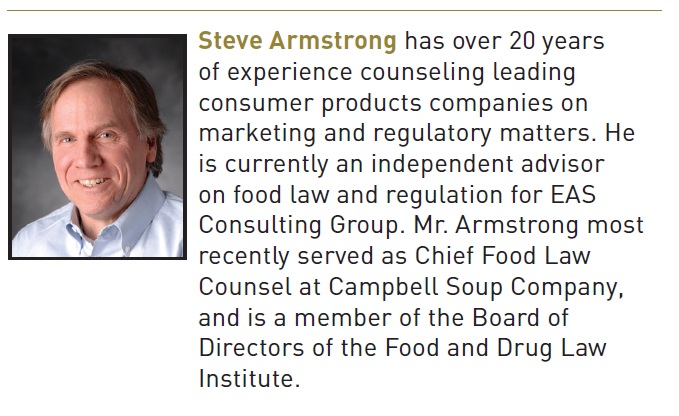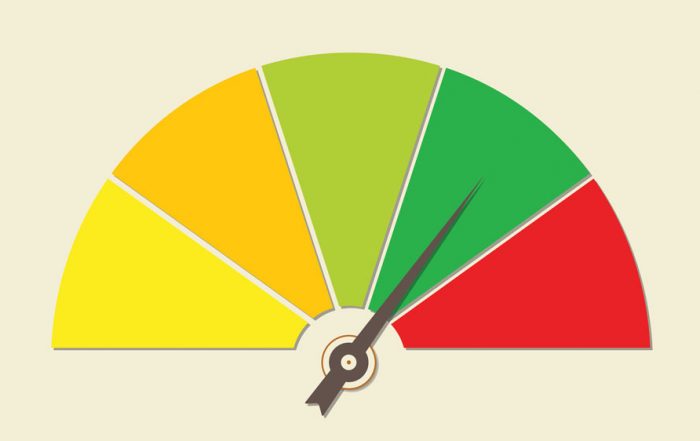
Process Labeling: The Challenges of Transparency
by Steve Armstrong
It’s nearly impossible these days to do grocery shopping without running into a label that says something about how a food was made, where it came from or, more often than not, what kinds of things were not done to the food. Claims about how food was grown, produced, prepared and packaged—and, in particular how the earth and its inhabitants were treated along the way—have cropped up in nearly every aisle in the supermarket. It’s hard to avoid “fair trade” coffee, “cage-free” eggs, “rBST-free” milk, or “Non-GMO” orange juice, not to mention products claiming to be “natural” or “organic.” Process labeling is coming to predominate our food marketing, quite often taking precedence over more traditional food attributes. To take but one example, the principal display panel of a current meat product proclaims that it is “100% grass fed,” “free range,” “all natural,” “minimally processed” and with no antibiotics or added hormones. Crowded tight with all these claims, the front panel says nothing about the attributes that have long been held to define food—taste, aroma, and nutrition.1
 Given the increasing popularity of process labeling, it is essential for marketers and their advisors to understand the challenges of making these claims and the legal standards that apply to them. While such claims may seem attractive to food companies seeking a competitive advantage or greater transparency, it can prove challenging to ensure that they are truthful, non-misleading, and adequately substantiated. Success requires a sound scientific basis for the claim, strict supply chain oversight and control, and clear, direct, and properly qualified language in labeling. Anyone undertaking these challenges should understand clearly why process labeling claims are so popular. It’s also necessary to understand how the misbranding and deception principles of the Federal Food Drug, and Cosmetic Act (FDCA)2 and the Federal Trade Commission Act (FTC Act), including the FTC’s Policy Statement on Deception (Deception Policy) and its Guides for the Use of Environmental Marketing Claims (Green Guides)3 can help chart the path toward diligent compliance and consumer satisfaction.
Given the increasing popularity of process labeling, it is essential for marketers and their advisors to understand the challenges of making these claims and the legal standards that apply to them. While such claims may seem attractive to food companies seeking a competitive advantage or greater transparency, it can prove challenging to ensure that they are truthful, non-misleading, and adequately substantiated. Success requires a sound scientific basis for the claim, strict supply chain oversight and control, and clear, direct, and properly qualified language in labeling. Anyone undertaking these challenges should understand clearly why process labeling claims are so popular. It’s also necessary to understand how the misbranding and deception principles of the Federal Food Drug, and Cosmetic Act (FDCA)2 and the Federal Trade Commission Act (FTC Act), including the FTC’s Policy Statement on Deception (Deception Policy) and its Guides for the Use of Environmental Marketing Claims (Green Guides)3 can help chart the path toward diligent compliance and consumer satisfaction.
Rise in Popularity
Mounting evidence of the popularity of process labeling claims can readily be seen in the United States and markets around the world. For one thing, consumer purchases of organic foods have reached record levels, amounting to over $43 billion last year, and up 11% over the previous year.4 In addition, the market for “eco” labels is robust, with the Eco Label Index listing more than 460 labels in use in nearly 200 countries, covering 25 industry sectors.5 A recent survey of consumers conducted by the U.S. Farmers and Ranchers Alliance found that 70 percent said their purchasing decisions were affected by how food was grown and raised, and three-quarters said they think about these issues while grocery shopping.6 Food companies are embracing process labeling in the name of “transparency” with many committing to providing more information via labeling about how food is produced.7
A study published in 2015 by the nonprofit Council on Agriculture Science and Technology (CAST) helps explain the phenomenon.8 Because much of our food comes to us from a global supply chain, the study said, we as consumers have little opportunity to see production processes directly or know much about them. This fact can give rise to worries and concerns about how food is made and whether best practices are always followed. The study attributed interest in process labeling to “desires for individual control and a diffuse distrust in the safety and health of food produced by modern agriculture.”9 Other observers have said that, ironically, the industry’s success in putting safe, nourishing, and relatively inexpensive food on the tables of Americans has fueled the interest
in food production and calls for transparency:
As top concerns for consumers are already largely being met, there is a freedom that was not historically available to delve deeper into food issues, to ponder how food was grown and raised and to think about these matters while checking out. Consumers are not wrong for doing this; it is the fundamental right of the consumer to question.10
When viewed in the context of dramatic advances in food production, coupled with emerging consumer concerns over safety, health, and the environment, “it should not be surprising that some consumers are demanding more information—via labeling—about how their food is produced.”11
The Case for—and Against—Process Labels
The process-labeling phenomenon presents an opportunity for a food company seeking greater transparency with consumers. The CAST study found that process labels “can effectively bridge the informational gap between producers and consumers, satisfy consumer demand for broader and more stringent quality assurance criteria, and ultimately create value for both consumers and producers.”12 In particular, process labeling can help a food company aspiring toward transparency convince consumers that its values align with theirs.
Unfortunately, a process labeling claim is often presented without any qualification or other information that could help explain how it fits into a transparency mission. This is, no doubt, because many process-related issues are complex and difficult to execute. Providing information sufficient to explain an issue can take up valuable labeling space and risk losing those with short attention spans. On the other hand, truncated communications can alienate, confuse, or even mislead concerned consumers.
Consider the label of a current canned tuna claiming prominently to be “sustainable.” The terms “pole” and “troll-caught” appear next to the claim. On a side panel, one sees dolphin and turtle logos and “FADs” circled in red and crossed out. No explanation accompanies the fishing terms, the logos, or the acronym. However, an Internet search can reveal that the acronym stands for “Fish Aggregating Device,” a controversial method of commercial, deep-sea fishing using long, cylindrical nets that float unattended across the oceans and can presumably snare dolphins, turtles, and just about anything that swims by. Yet the label does not say whether the product avoids FADs altogether or why the alternate methods are preferable, much less their impact on dolphins, turtles, and other sea creatures.
In addition to leaving consumers confused, failure to provide qualifying or explanatory information can also run the risk that a process label—particularly one about a process that is avoided—can stigmatize conventional products. The authors of the CAST study found that process labels frequently leave that kind of impression “because the [process] label portrays the conventional product in an implicitly negative way.”13 The authors saw a particular danger here:
This type of stigmatization of the conventional product can be particularly problematic in situations in which no scientific evidence exists that the food produced with the conventional process causes harm, or even that it is compositionally any different.14
The potentially unintended and undesirable consequences include increasing food prices, introducing unwarranted quality or health expectations and, in the end, “stunting scientific and technological advances in agriculture.”15 Indeed, FDA has long advised that “Non-GMO” claims should not suggest that a food is safer or more nutritious simply because it avoided the use of genetic engineering.16 Still, “Non-GMO” continues to be a popular claim, often appearing without any information why consumers should care that their food was made without ingredients derived from genetic engineering.
The right amount of explanatory information on the label or an accompanying website can address these issues. While it may not be possible to explain all the environmental benefits of certain fishing practices on the label of a five-ounce can of tuna, there surely is enough space for “Learn about our sustainable fishing practices,” accompanied by a URL for a website discussing the issue in greater detail. Further, where the non-use of GMOs does not result in a food that is materially different, that fact should be disclosed in the labeling, along with a reassurance that FDA regards GMO foods as safe for consumption.
The Questions for Marketers
While process labeling can effectively respond to consumers wanting a stronger connection to their food, it’s necessary, in the first instance, to determine what issues are relevant to consumers, just how much information they want and how much is necessary to ensure that the communication, in context, is truthful and non-misleading. Balancing these competing objectives is not easy. At a minimum, process claims such as “Non-GMO” or “no FADs,” should include enough information to make clear what the process-related attribute delivers—and what it doesn’t.
Answers to these questions can begin to emerge when considering the labeling requirements of the FDCA and the deception safeguards set forth in the FTC Act, as interpreted by the FTC’s Deception Policy and Green Guides. The core provisions of these laws and policies have special relevance to process labeling claims and can provide the framework for a thorough and well-grounded analysis.
Analyzing Process Labeling Claims
The FTC’s Deception Policy provides that a marketing claim is deceptive if it is likely to mislead consumers acting reasonably under the circumstances and is material to consumers’ purchasing decisions.17 To determine whether deception has occurred, marketers must identify all of the express and implied messages that the claim conveys to a reasonable consumer in the context in which the claim is presented.18
The FTC’s Green Guides require that environmental benefit claims be clear, specific, and accompanied by adequate disclaimers and disclosures.19 Information necessary to explain the message and prevent deception must be disclosed prominently, unambiguously, and in direct conjunction with the claim itself.20 The Green Guides also make clear that claims of a “general environmental benefit,” whether made directly or by implication, are deceptive and must be avoided.21 The labeling of a product proclaiming to be “eco-wise,” “earth friendly,” or even “Non-GMO” would therefore do well to explain clearly and specifically what sort of environmental benefit the product delivers.
The standards applicable to labeling under the FDCA are the same, if not a bit stricter. The FDCA provides that a food is misbranded if its labeling is “false or misleading in any particular.” (emphasis added)22 The FDCA also focuses on omissions. A product can be misbranded not only because of the representations made for it in labeling, but also if that labeling “fails to reveal facts material in light of such representations[.]”23 In other words, labeling can be misbranded if it leaves out any significant information, i.e., information that could affect the consumer’s judgment about the product and influence the buying decision, such as the notion that a non-GMO food is not, in all likelihood, materially different from a product made from genetically engineered ingredients.and influence the buying decision, such as the notion that a non-GMO food is not, in all likelihood, materially different from a product made from genetically engineered ingredients.
The FDCA has long been understood as holding a producer strictly accountable for every reasonable understanding of every claim made in labeling, including messages that a consumer could reasonably infer from the words and images on the label. To take one well-known example, an “apple cider vinegar” that is actually made from dried apple powder was judged misbranded because a reasonable understanding of the labeling was that the product was made from whole apples.24
Clearly, it is essential to determine what information is necessary to understanding a process labeling claim, and whether the labeling has left anything out that may affect the purchasing decision. Also, to the extent that process labeling claims require elaboration on a website or other linkage, the same strict standards apply. FDCA’s prohibition on statements that are false or misleading “in any particular” extends to “labeling,” i.e., any written, printed, or graphic matter on “or accompanying” the container.25
Communication Challenges
For process labeling claims, it’s hard to overstate the importance of the first step in the analysis—identifying all the messages, both explicit and implicit, that are reasonably conveyed by the labeling or advertising in the context in which the claim is presented. This is especially important, because process labeling claims can be highly inferential, i.e., they are capable of sending a great variety of implied messages and reassurances. While some may be accurate, others may be quite off the mark.
Problematic inferences can arise simply by virtue of the position that the process claim occupies on the label in relation to other labeling elements or the failure to provide an adequate disclosure about what the claim does and doesn’t mean for the average consumer. A process claim presented prominently on the front panel—e.g., “natural,” “organic,” or “non-GMO”—in the company of equally prominent nutrition, health, or wellness messages, can leave consumers with a powerful impression that the touted process has helped make the food safer or healthier, when, as often as not, the process has done nothing of the sort. And silence, i.e., the failure to offer any qualification, explanation or disclaimer, can leave much room for the reasonable consumer to imagine benefits where none exist.
Case Studies
Claims about a food’s non-use of GMOs, which can readily mislead consumers unless accompanied by adequate disclosures, are a case in point. A recent survey concluded that an overwhelming majority of consumers worldwide think non-GMO foods are healthier than foods made with GMOs.26 However, FDA has found no scientific basis to require GMO labeling because the scientific consensus—announced not only by FDA but at least a half- dozen other respected scientific organizations—is that GMO foods are safe and not materially different from non-GMO foods.27
Now, in light of these facts, consider the label of a popular granola bar, covered with attractive claims—“100% whole grains” that are “super,” “healthy” and “gluten free”—and which also shows the following statements prominently, right alongside each other on the principal display panel:
HEALTHY
NON-GMO
Does this placement imply that non-GMO foods are healthier than their conventional competitors? Or at least create an ambiguity? Is it a reasonable understanding? At any rate, the label does not disclose the scientific consensus that GMOs are safe and that avoiding them does not bring a health benefit. No information reflecting that consensus is provided, leaving a reasonable consumer with the mistaken impression that the avoidance of GMOs might indeed contribute to good health. The inference could have been avoided if the label had noted FDA’s position on the same panel, or at least on an adjoining one, an approach that is strongly suggested by the Green Guides.28 An effective disclaimer could have stated simply, “Foods that avoid using GMOs are not healthier than GMO foods. FDA considers GMO crops to be safe.” A link to FDA’s policies on bioengineering and GMO labeling would have helped reinforce the message.
Disclosures and disclaimers can provide information necessary for a consumer to understand a process labeling claim and consider whether it has any significance from a health, safety, or environmental perspective. When no meaningful difference exists, or where the benefit of the process is negligible, it’s important to convey that information.29 The Green Guides require that disclosures be “clear and prominent,” in plain language, and placed in close proximity to the claim.30 This means that where the claim is made on the principal display panel, the disclaimer belongs there as well. For example, milk containers will sometimes advertise their non-use of rBST, but at the insistence of some state regulators, such labels make clear, on the same panel, that the practice does not result in milk that is significantly different from milk that has not undergone the rBST removal process.
Officials at USDA’s Food Safety and Inspection Service (FSIS) who review the labels of meat and poultry products before they are released into the market, routinely allow certain process claims, but only with the appropriate disclaimers appearing immediately next to the claims. For example, a pork product claiming to be raised without antibiotics must include the disclaimer, “Federal Regulations Prohibit the Use of Hormones in Pork” directly next to or underneath the claim. A promise of “no nitrites or nitrates added” must also specify, next to the claim, the ingredients in which nitrites and nitrates occur naturally. USDA also permits qualifying products to claim that they are “natural,” but requires the following explanation next to the claim: “No artificial ingredients / Minimally processed.”
Marketers and their advisors must consider process labeling communications carefully and with a clear eye to what is and is not being conveyed to the reasonable consumer, both directly and by implication. Only then can it be determined what information needs to be included so that the consumer understands the claim and its significance in clear and unambiguous terms. This is not an easy task, and, of course, the job of ensuring that the claim is supported by adequate technical and scientific data brings challenges of its own.
Substantiation Challenges
The FTC Policy Statement Regarding Advertising Substantiation requires that every marketing claim have a “reasonable basis” in fact.31 For a process labeling claim, this typically means that the quality, sourcing, and manufacturing operations are implementing a well-defined process that is reasonably designed to support the claim. Such a process should be well-established, clearly delineated, thoroughly documented and continuously monitored, with corrective actions being made promptly whenever errors occur. In this kind of effort, the challenges usually fall into two major categories.
First, process labeling claims require a “process” that is best defined by a standard that is fixed either by the government or a well-established, independent scientific or technical agency. The standards for organic farming set by the USDA’s National Organic Program are an example of such a third-party standard.32 USDA’s systems of grading meat, poultry, butter, and eggs, and requiring Country of Origin Labeling (COOL) are also well-defined process standards.33 Sellers, buyers, trade groups, and industry associations have also established quality standards and guidelines against which process labeling claims can be measured.34 However, it is hard, if not impossible, to find widely accepted, well-established definitions for some of the most popular process claims, such as “cage-free,” “grass-fed,” “free range,” “naturally raised,” and many others.35 In these cases, a manufacturer needs to put its own, self-defined process into place, along with a well-established and detailed Quality Management System (QMS) reasonably designed ensure compliance with that process.36
Second, even with a well-defined standard, supporting process labeling claims on an ongoing basis can be quite a job, especially for large-scale operations with far-flung suppliers. Adequate substantiation requires supply chains operating under strict control, with rigorous oversight, continuous monitoring, and regular verification and auditing. The food producer must maintain strong and transparent supplier relationships, with detailed, fully negotiated quality assurance contracts, and even then, the producer should check in frequently to assure that the operation is running as agreed, without errors or gaps. If any mistakes occur, corrective action must be taken immediately.37
Verification by independent third parties is helpful, and producers can obtain that kind of assistance from the USDA’s Agricultural Marketing Service (AMS), which provides a wide variety of independent verification services through its Process Verified Program (PVP), a voluntary, user-fee-funded program. The PVP is based on the principal that only a robust QMS can turn out a product with a consistent and reliable level of quality assuring, for example, that every unit can deliver faithfully on the promise of a process-related labeling claim. Under the PVP, an applicant submits its QMS for a desk review and an in-person audit by AMS personnel. The agency uses highly trained auditors to conduct inspections and review processes and documentation so as to assure that a producer is adhering to QMS standards that can reasonably support the process claim.38
At the end of the review process, a manufacturer is permitted to market the products made under the audited system as “USDA Process Verified” along with the USDA shield. The marketing claims that have received approval under the PVP include non-use of hormones and antibiotics, specific feeding and management claims, and even accreditation for farms that are “in transition” to USDA Organic Certification.39 In fact, a supplier recently arranged for AMS to certify that its process could deliver “USDA Process Verified Non-GMO” grains.40
Conclusion
Process labeling claims must be used thoughtfully, and with careful attention paid to context, consumer perception, and messaging. It is essential to think critically about all the messages that the labeling elements and their relative placement may reasonably convey and structure the communication to ensure that the consumer understands the significance of the claim. Disclosures necessary to avoid any unsupported messages must be provided, since a process by itself may not necessarily promote wellness or safety, or even produce a material difference. Processes and systems that can support the claim have to be established and monitored on a continuing basis.
In the end, marketers and their advisors will likely find that process labeling is worth the effort because it can connect a product with the core values of consumers who want the products they buy to say something about who they are—or who they might wish to be. But execution is neither simple nor straightforward. It’s a project that requires honesty, care, and hard work.
- Nutrilab, Inc. v. Schweiker, 713 F.2d 335 (7th Cir. 1983), discussing Federal Food, Drug, and Cosmetic Act § 201(g)(1)(C), 21 U.S.C. § 321(g)(1)(C).
- Federal Food, Drug, and Cosmetic Act, §§ 201, 403; 21 U.S.C. § 321, 343.
- Federal Trade Commission Act §§ 5, 12-15; 15 U.S.C. §§ 45, 52-55; FTC Policy Statement on Deception, October 11, 1983, Appended to Cliffdale Associates, Inc., 103 F.T.C. 110, 174 (1984) https://www.ftc.gov/system/files/documents/public_statements/410531/831014deceptionstmt.pdf; Guide to Environmental Marketing Claims, 16 C.F.R., Part 260, https://www.ftc.gov/enforcement/rules/rulemaking-regulatory-reform-proceedings/green-guides.
- “U.S. Organic Sales Post New Record,” Organic Trade Association, May 16, 2016 (See https://www.ota.com/news/press-releases/19031).
- http://www.ecolabelindex.com.
- http://www.cattlenetwork.com/news/industry/us-farmers-and-ranchers-alliance-survey-reveals-consumers-attitudes-sustainability-and.
- See, e.g., “Consumers Demand Transparency in the Food Industry,” Prepared Foods, January 24, 2017 (see http://www.preparedfoods.com/articles/119315-consumers-demand-transparency-in-the-food-industry); “Food Companies on the Front Line of a Transparency Revolution,” Center for Food Integrity, September 15, 2016 (see http://www.foodintegrity.org/blog/2016/09/15/food-companies-on-the-front-line-of-a-transparency-revolution); “Campbell Labels Will Disclose GMO Ingredients,” New York Times Business Day, January 7, 2016 (See https://www.nytimes.com/2016/01/08/business/campbell-labels-will-disclose-gmo-ingredients.html?_r=0).
- “Process Labeling of Food: Consumer Behavior, the Agricultural Sector, and Policy Recommendations,” Issue Paper No. 56, Council for Agricultural Science and Technology, October 2015 (Available for download at https://www.cast-science.org/download.cfm?PublicationID=283819&File=10306205e87081c6f250782a2f3b38423751TR).
- CAST Issue Paper No. 56, at p. 1.
- The Communication Scarcity in Agriculture, J. Eise, W. Hode (New York, N.Y. 2017), at p. 46.
- Id.
- Cast Issue Paper No. 56, at p. 1.
- Id. at p. 12.
- Id. at p. 1.
- Id. at p. 2.
- “Guidance for Industry: Voluntary Labeling Indicating Whether Foods Have or Have Not Been Derived from Genetically Engineered Plants,” November 2015, at Section III.B (see https://www.fda.gov/RegulatoryInformation/Guidances/ucm059098.htm).
- Deception Policy, Section III.
- Id.
- Green Guides, 16 C.F.R. § 260.3(a).
- Id.
- Green Guides, 16 C.F.R. § 260.4.
- FDCA § 403(a)(1); 21 U.S.C. § 343(a)(1).
- FDCA § 201(n); 21 U.S.C. § 321(n).
- U.S. v. 95 Barrels, More of Less, Alleged Apple Cider Vinegar, 265 U.S. 438, (1924).
- FDCA § 201(m); 21 U.S.C. § 321(m).
- “87% of Consumers Globally Think Non-GMO is ‘Healthier,’ But Where’s the Evidence?” E. Watson, Food Navigator, August 13, 2015 (see http://www.foodnavigator-usa.com/Manufacturers/87-of-consumers-globally-think-non-GMO-is-healthier).
- Id., and “Statement of Policy – Foods Derived From New Plant Varieties,” FDA, Federal Register, Volume 57, May 29, 1992 at Section V (see https://www.fda.gov/Food/GuidanceRegulation/GuidanceDocumentsRegulatoryInformation/Biotechnology/ucm096095.htm).
- Green Guides, 16 C.F.R. § 260.3(a).
- The CAST study strongly recommended that process labels claiming a product is “free of” a certain production related process should disclose the current scientific consensus regarding the importance (or non-importance) of that attribute. CAST Issue Paper No. 56, at p. 13.
- Green Guides, 16 C.F.R. § 260.3(a).
- FTC Policy Statement Regarding Advertising Substantiation, March 11, 1983, appended to Thompson Medical Co., 104 F.T.C. 648, 839 (1984), aff’d, 791 F.2d 189 (D.C. Cir. 1986), cert. denied, 479 U.S. 1086 (1987).; (see https://www.ftc.gov/public-statements/1983/03/ftc-policy-statement-regarding-advertising-substantiation).
- 7 C.F.R, Part 205.
- https://www.ams.usda.gov/services/grading; 7 C.F.R. Parts, 60 and 65.
- See, e.g., “Recommended Animal Handling Guidelines and Audit Guide,” American Meat Institute, July 2013 (see http://www.animalhandling.org/ht/d/sp/i/26752/pid/26752); “Animal Husbandry Guidelines,” United Egg Producers, June 2016 (see http://uepcertified.com).
- “Understanding Food Labels: How Much Do Food Labels Actually Tell You?” Food & Water Watch, April 11, 2017 (See https://foodandwaterwatch.org/about/live-healthy/consumer-labels).
- Where a process is self-defined, the producer should take care to qualify the process labeling claim by explaining, for example, why the product can be called “naturally raised” or “free range.”
- The same kind of supplier relationships will help ensure compliance with the Food Safety Modernization Act and the Foreign Supplier Verification Program. FDCA §§ 418, 805, 21 U.S.C. §§ 350g, 384a. Whenever errors occur, a producer should be prepared to withdraw the claim and recall the product whenever errors have occurred and the claimed process steps were not followed.
- 7 C.F.R., Part 62.
- USDA announced in February that it was accepting applications from farmers wishing to certify that their operations were in transition to organic certification. https://www.ams.usda.gov/services/auditing/certified-
transitional. - “U.S. Approves SunOpta System for Detecting Genetically Modified Crops,” New York Times Business Day, May 15, 2015; (see https://www.nytimes.com/2015/05/16/business/us-approves-sunopta-system-for-detecting-genetically-modified-crops.html).
Update Magazine
July/August 2017










